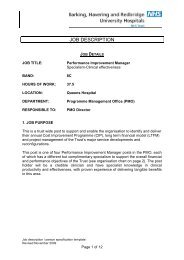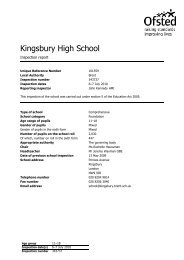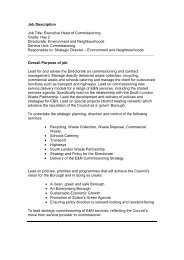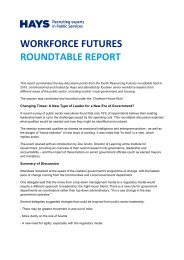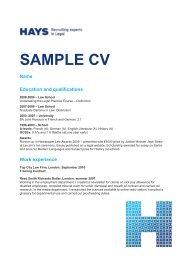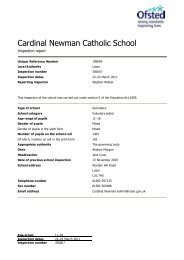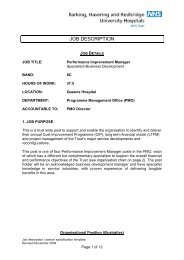RESOURCING AND TALENT PLANNING - Hays
RESOURCING AND TALENT PLANNING - Hays
RESOURCING AND TALENT PLANNING - Hays
You also want an ePaper? Increase the reach of your titles
YUMPU automatically turns print PDFs into web optimized ePapers that Google loves.
2012<br />
Table 5: What are the main factors that influence your choice of recruitment partner? (% of<br />
respondents)<br />
Access to highly skilled<br />
candidates<br />
All<br />
organisations<br />
Manufacturing<br />
and production<br />
Private<br />
services<br />
Public<br />
sector<br />
Not-for-profit<br />
sector<br />
54 62 54 42 56<br />
Cost 52 53 51 46 60<br />
Existing relationships with<br />
recruitment partners<br />
Involvement with my<br />
organisation’s industry<br />
42 47 43 37 35<br />
31 35 32 22 35<br />
Reputation 30 44 27 22 30<br />
Personal recommendation 10 12 10 5 13<br />
Global reach 6 12 6 2 3<br />
Other 7 4 6 11 6<br />
Base: 500<br />
Length of recruitment process<br />
One in three (33%) organisations report that<br />
they have lost potential recruits due to the length<br />
of their recruitment process. This issue appears<br />
to be exacerbated by organisation size. Threefifths<br />
(59%) of organisations with more than<br />
5,000 employees report that the length of their<br />
recruitment process has led to the loss of potential<br />
recruits compared with 46% of organisations with<br />
1,000–4,999 employees and about one-quarter of<br />
smaller organisations. There were no significant<br />
sector differences once size was taken into account.<br />
Recruitment difficulties<br />
Despite the high unemployment rate, 82% of<br />
organisations reported difficulties in filling at least<br />
some vacancies over the past few months. This is<br />
an increase on the previous two years (2011: 75%,<br />
2010: 68%) and more in line with previous years,<br />
before the full impact of the economic downturn<br />
(2009: 81%; 2008: 86%).<br />
All sectors report more difficulties this year<br />
compared with last, although the biggest increase<br />
is noted in the public sector (Table 6). Table 7<br />
suggests this is partly due to a step increase in filling<br />
vacancies for senior managers/directors. This increase<br />
is observed in all sectors but is particularly the case<br />
in the public sector, where the proportion reporting<br />
recruitment difficulties in this area has doubled<br />
compared with last year. The ongoing austerity<br />
measures and pay freezes in the public sector,<br />
coupled with the challenges of widespread reforms,<br />
may reduce its attractiveness to potential recruits.<br />
Table 6: Organisations experiencing difficulties recruiting for one or more category of vacancy in the<br />
past few months, by organisation size (% of those that have had vacancies to fill)<br />
Difficulty filling one or<br />
more vacancies<br />
All<br />
organisations<br />
Manufacturing<br />
and production<br />
Private<br />
services<br />
Public<br />
sector<br />
Not-for-profit<br />
sector<br />
2012 82 91 82 82 70<br />
2011 75 88 77 66 62<br />
Base: 486 (2012); 561 (2011)<br />
<strong>RESOURCING</strong> <strong>AND</strong> <strong>TALENT</strong> <strong>PLANNING</strong> 2012<br />
11





